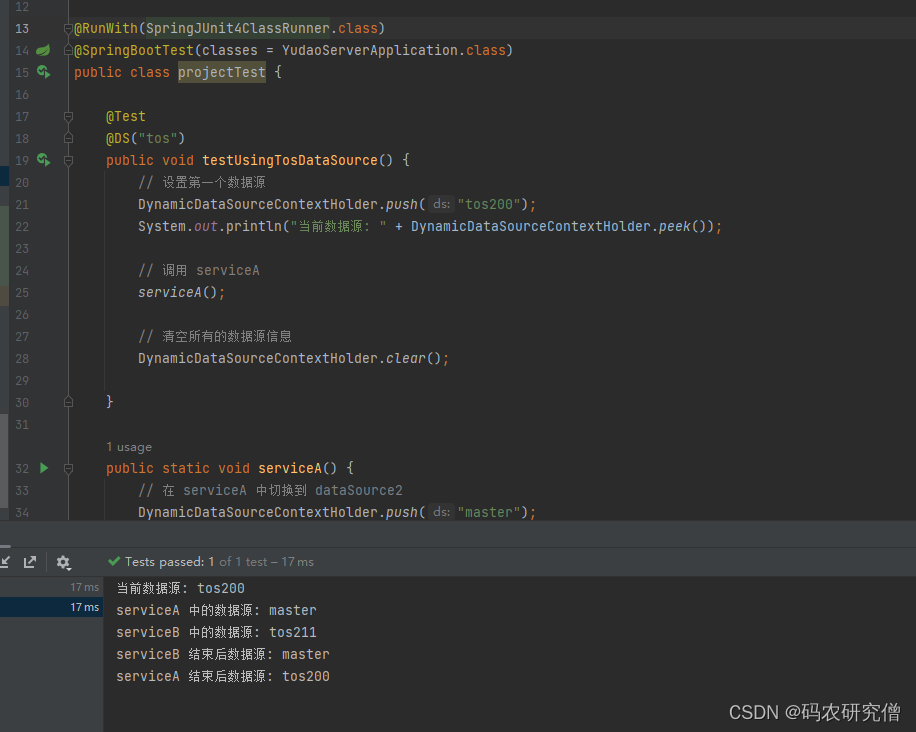目录
- 前言
- [1. 基本知识](#1. 基本知识)
- [2. Demo](#2. Demo)
- [3. 实战](#3. 实战)
-
- [3.1 项目测试](#3.1 项目测试)
- [3.2 功能测试](#3.2 功能测试)
前言
书写测试类,一般只需要加入@Test即可,但是结合Springboot项目来整体测试对应需要怎么下手
详细的Java知识点推荐阅读:java框架 零基础从入门到精通的学习路线 附开源项目面经等(超全)
1. 基本知识
涉及测试类的基本注解分析如下:
一、@SpringBootTest:加载完整的Spring应用上下文
使用场景:需要测试整个Spring Boot应用时使用,确保所有的Bean都能被正确加载
java
@SpringBootTest
public class MyApplicationTests {
// 测试方法
}二、@RunWith(SpringRunner.class):指定测试运行器,这里使用SpringRunner来运行Spring Boot测试
使用场景:结合JUnit 4使用时指定测试运行器
java
@RunWith(SpringRunner.class)
public class MyApplicationTests {
// 测试方法
}三、@Autowired:自动注入Spring管理的Bean
使用场景:在测试类中需要注入服务、仓库等Bean时使用
java
@Autowired
private MyService myService;四、@Slf4j:使用Lombok提供的日志记录功能
使用场景:需要在类中记录日志时使用
java
@Slf4j
public class MyApplicationTests {
// 可以使用log.info(), log.debug()等记录日志
}五、@Test:标记一个方法为测试方法
使用场景:任何需要进行单元测试的方法都应使用该注解
java
@Test
public void testMethod() {
// 测试逻辑
}常出现的情况有如下:
-
注入的Bean为null
使用@Autowired注入的Bean为null
》》》》确保被注入的类被Spring管理(例如,使用@Service、@Component等注解),确保测试类使用@SpringBootTest注解以加载完整的Spring上下文 -
测试类无法加载上下文
测试类无法加载Spring上下文,抛出BeanCreationException等异常
》》》》确保@SpringBootTest注解的classes属性指向正确的主应用程序类,例如AccidentApplication.class
2. Demo
结合实战中的Demo进行讲解
java
import com.sinosoft.springbootplus.AccidentApplication;
import lombok.extern.slf4j.Slf4j;
import org.junit.jupiter.api.Test;
import org.springframework.beans.factory.annotation.Autowired;
import org.springframework.boot.test.context.SpringBootTest;
import org.springframework.test.context.junit4.SpringRunner;
@SpringBootTest(classes = AccidentApplication.class)
@Slf4j
public class TestClass {
@Autowired
private XXXService xxxService;
@Test
public void testDemo() {
// 示例测试代码
log.info("Starting testDemo");
// 调用XXXService的某个方法,并进行断言
String result = xxxService.someMethod();
assertNotNull(result);
log.info("testDemo completed");
}
}其中的注意事项如下:
- 类路径:确保AccidentApplication类在你的类路径下,并且可以被正确加载
- Service注入:XXXService必须在Spring上下文中被定义为一个Bean,否则@Autowired注入会失败
- JUnit版本 :确保项目使用JUnit 5(JUnit Jupiter)或者JUnit 4,不要混用
上面的代码中使用的是JUnit 5,如果你需要使用JUnit 4,请使用org.junit.Test和org.junit.runner.RunWith - 日志使用:通过@Slf4j注解,可以在测试方法中方便地记录日志,这有助于调试
而且基本的项目结构如下:
java
src
├── main
│ └── java
│ └── com
│ └── manong
│ └── springbootplus
│ ├── AccidentApplication.java
│ └── service
│ └── XXXService.java
└── test
└── java
└── com
└── manong
└── springbootplus
└── TestClass.java3. 实战
3.1 项目测试
Demo与实战中大同小异,上述使用的是JUnit 5 ,下面使用一个JUnit 4进行演示
java
import org.junit.Test;
import org.junit.runner.RunWith;
import org.springframework.boot.test.context.SpringBootTest;
import org.springframework.test.context.junit4.SpringJUnit4ClassRunner;
@RunWith(SpringJUnit4ClassRunner.class)
@SpringBootTest(classes = YudaoServerApplication.class)
public class projectTest {
@Test
public void testUsingTosDataSource() {
}
}实际截图如下:

3.2 功能测试
实战中可能有多个模块,对应的配置需如下:
java
package cn.example.module.dangerous.service.enterpriseregistry;
import org.junit.jupiter.api.Disabled;
import org.junit.jupiter.api.Test;
import org.springframework.boot.test.mock.mockito.MockBean;
import javax.annotation.Resource;
import cn.example.framework.test.core.ut.BaseDbUnitTest;
import cn.example.module.dangerous.controller.admin.enterpriseregistry.vo.*;
import cn.example.module.dangerous.dal.dataobject.enterpriseregistry.EnterpriseRegistryDO;
import cn.example.module.dangerous.dal.mysql.enterpriseregistry.EnterpriseRegistryMapper;
import cn.example.framework.common.pojo.PageResult;
import javax.annotation.Resource;
import org.springframework.context.annotation.Import;
import java.util.*;
import java.time.LocalDateTime;
import static cn.hutool.core.util.RandomUtil.*;
import static cn.example.module.dangerous.enums.ErrorCodeConstants.*;
import static cn.example.framework.test.core.util.AssertUtils.*;
import static cn.example.framework.test.core.util.RandomUtils.*;
import static cn.example.framework.common.util.date.LocalDateTimeUtils.*;
import static cn.example.framework.common.util.object.ObjectUtils.*;
import static cn.example.framework.common.util.date.DateUtils.*;
import static org.junit.jupiter.api.Assertions.*;
import static org.mockito.Mockito.*;
/**
* {@link EnterpriseRegistryServiceImpl} 的单元测试类
*
* @author 管理员
*/
@Import(EnterpriseRegistryServiceImpl.class)
public class EnterpriseRegistryServiceImplTest extends BaseDbUnitTest {
@Resource
private EnterpriseRegistryServiceImpl enterpriseRegistryService;
@Resource
private EnterpriseRegistryMapper enterpriseRegistryMapper;
@Test
public void testCreateEnterpriseRegistry_success() {
// 准备参数
EnterpriseRegistrySaveReqVO createReqVO = randomPojo(EnterpriseRegistrySaveReqVO.class).setId(null);
// 调用
Long enterpriseRegistryId = enterpriseRegistryService.createEnterpriseRegistry(createReqVO);
// 断言
assertNotNull(enterpriseRegistryId);
// 校验记录的属性是否正确
EnterpriseRegistryDO enterpriseRegistry = enterpriseRegistryMapper.selectById(enterpriseRegistryId);
assertPojoEquals(createReqVO, enterpriseRegistry, "id");
}
@Test
public void testUpdateEnterpriseRegistry_success() {
// mock 数据
EnterpriseRegistryDO dbEnterpriseRegistry = randomPojo(EnterpriseRegistryDO.class);
enterpriseRegistryMapper.insert(dbEnterpriseRegistry);// @Sql: 先插入出一条存在的数据
// 准备参数
EnterpriseRegistrySaveReqVO updateReqVO = randomPojo(EnterpriseRegistrySaveReqVO.class, o -> {
o.setId(dbEnterpriseRegistry.getId()); // 设置更新的 ID
});
// 调用
enterpriseRegistryService.updateEnterpriseRegistry(updateReqVO);
// 校验是否更新正确
EnterpriseRegistryDO enterpriseRegistry = enterpriseRegistryMapper.selectById(updateReqVO.getId()); // 获取最新的
assertPojoEquals(updateReqVO, enterpriseRegistry);
}
@Test
public void testUpdateEnterpriseRegistry_notExists() {
// 准备参数
EnterpriseRegistrySaveReqVO updateReqVO = randomPojo(EnterpriseRegistrySaveReqVO.class);
// 调用, 并断言异常
assertServiceException(() -> enterpriseRegistryService.updateEnterpriseRegistry(updateReqVO), ENTERPRISE_REGISTRY_NOT_EXISTS);
}
@Test
public void testDeleteEnterpriseRegistry_success() {
// mock 数据
EnterpriseRegistryDO dbEnterpriseRegistry = randomPojo(EnterpriseRegistryDO.class);
enterpriseRegistryMapper.insert(dbEnterpriseRegistry);// @Sql: 先插入出一条存在的数据
// 准备参数
Long id = dbEnterpriseRegistry.getId();
// 调用
enterpriseRegistryService.deleteEnterpriseRegistry(id);
// 校验数据不存在了
assertNull(enterpriseRegistryMapper.selectById(id));
}
@Test
public void testDeleteEnterpriseRegistry_notExists() {
// 准备参数
Long id = randomLongId();
// 调用, 并断言异常
assertServiceException(() -> enterpriseRegistryService.deleteEnterpriseRegistry(id), ENTERPRISE_REGISTRY_NOT_EXISTS);
}
@Test
@Disabled // TODO 请修改 null 为需要的值,然后删除 @Disabled 注解
public void testGetEnterpriseRegistryPage() {
// mock 数据
EnterpriseRegistryDO dbEnterpriseRegistry = randomPojo(EnterpriseRegistryDO.class, o -> { // 等会查询到
o.setEnterpriseName(null);
o.setCreditCode(null);
o.setRegistrant(null);
o.setCreateTime(null);
o.setEnterpriseCode(null);
o.setContactNumber(null);
});
enterpriseRegistryMapper.insert(dbEnterpriseRegistry);
// 测试 enterpriseName 不匹配
enterpriseRegistryMapper.insert(cloneIgnoreId(dbEnterpriseRegistry, o -> o.setEnterpriseName(null)));
// 测试 creditCode 不匹配
enterpriseRegistryMapper.insert(cloneIgnoreId(dbEnterpriseRegistry, o -> o.setCreditCode(null)));
// 测试 registrant 不匹配
enterpriseRegistryMapper.insert(cloneIgnoreId(dbEnterpriseRegistry, o -> o.setRegistrant(null)));
// 测试 createTime 不匹配
enterpriseRegistryMapper.insert(cloneIgnoreId(dbEnterpriseRegistry, o -> o.setCreateTime(null)));
// 测试 enterpriseCode 不匹配
enterpriseRegistryMapper.insert(cloneIgnoreId(dbEnterpriseRegistry, o -> o.setEnterpriseCode(null)));
// 测试 contactNumber 不匹配
enterpriseRegistryMapper.insert(cloneIgnoreId(dbEnterpriseRegistry, o -> o.setContactNumber(null)));
// 准备参数
EnterpriseRegistryPageReqVO reqVO = new EnterpriseRegistryPageReqVO();
reqVO.setEnterpriseName(null);
reqVO.setCreditCode(null);
reqVO.setRegistrant(null);
reqVO.setCreateTime(buildBetweenTime(2023, 2, 1, 2023, 2, 28));
reqVO.setEnterpriseCode(null);
reqVO.setContactNumber(null);
// 调用
PageResult<EnterpriseRegistryDO> pageResult = enterpriseRegistryService.getEnterpriseRegistryPage(reqVO);
// 断言
assertEquals(1, pageResult.getTotal());
assertEquals(1, pageResult.getList().size());
assertPojoEquals(dbEnterpriseRegistry, pageResult.getList().get(0));
}
}